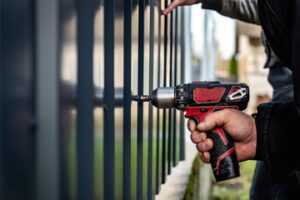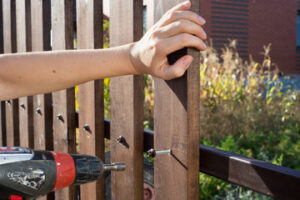Installing a fence can add privacy, increase your home’s value, and create a safe space for pets. However, the process can be difficult and dangerous if not done correctly.

A fence can add much to your property, from designating boundaries to creating a sense of privacy and security. However, before the fencing specialists can begin working on your new installation, there are a few important steps you will want to take to ensure that the project is a success.
Make sure that the area where you plan to build your fence is free of obstructions. This will help prevent any issues that may come up during the construction process and save you time and money in the long run. Remove large rocks, tree stumps, overgrown bushes and plants, and any other items that could impede the building of your fence.
Additionally, you will need to level the ground along your fence line. Using a shovel or rake, clear out any sections of the yard that are low and fill them up with dirt to make sure that your finished fence will stand straight and tall.
You will also want to check the ground for any underground elements that are in the vicinity of where your fence is planned to go. This includes things like sprinkler systems, gas lines to fire pits, and perimeter electrical wiring. By locating these items before your fence installation begins, you can work with your contractor to arrange for them to be moved to avoid any damage that can occur when post holes are dug.
Lastly, you will want to review any local rules and regulations that govern fence installations in your area. This can include height limitations, setback specifications, and permits. It is best to be aware of these guidelines in advance so that you can make necessary arrangements with the city or municipality.
Finally, you will want to speak with your neighbors to give them a heads-up about your fence plans. Keeping your neighbors in the loop will ensure that they are prepared for the noise and dust associated with construction as well as any possible inconveniences such as needing to relocate their underground wires or sprinkler systems. It will also prevent any potential misunderstandings or disputes down the road.
Know Your Property Lines
Property lines are the boundaries that legally define a piece of land. They can be determined by a number of things, including fences, hedges and even street curbs. While most homeowners are not going to overstep their bounds, it is important that they know where their property line begins and ends. This can help avoid potential legal problems and disputes with neighbors.
In many cases, a homeowner may be able to locate their property lines by simply reviewing the deed or plat map that is included with their home purchase. However, it is always a good idea to hire a professional surveyor to ensure that they are accurately measuring and locating the boundaries of a property before starting any work. A professional can also help a homeowner with the process of obtaining a building permit, which may be required before starting fence construction.
Aside from the obvious reasons why knowing property lines is important, it is also a good idea to do so for safety and insurance purposes. It is easy to accidentally cut through or damage an underground utility line by installing a fence too close to the boundary, which can result in costly repairs and damages. This is why it is always a good idea to check with local utility companies prior to beginning any work to ensure that the property is clear of any such lines.
Before attempting any type of fencing project, it is also a good idea to speak with your neighbors. While this is not a necessity in every situation, it can help prevent conflicts and other issues that could arise during the construction of a fence. For example, a neighbor may agree to split the cost of the fence with you or they might be willing to plant a hedge near the boundary line in order to keep your property from being visually obstructed.
It is also a good idea to contact the local zoning department or building permit office to find out if there are any specific rules and regulations that need to be followed when it comes to property lines and fencing. Many jurisdictions have zoning ordinances that must be adhered to in order for homeowners to build a fence, as well as setback requirements and other restrictions that need to be taken into account.
Invest in the Right Materials
It is important to invest in the right materials when it comes to fence installation. For example, the type of wood you choose will determine how well your fence stands up to weather and sun exposure.
Another factor to consider is the overall aesthetic of your fence. There are many different options, from traditional wood pickets to wrought iron and vinyl. The final decision depends on your personal style and budget. If you want to keep your costs down, you may have to sacrifice other features such as additional gates, upgraded finishes, ornate styles, and added landscaping features.
Before you begin building your fence, make sure to read the plat map to understand your property lines. This will help you avoid building over the line, which could lead to costly legal fees. Also, be aware of any underground utility lines in the area that might be impacted during construction. It is a good idea to contact local utility companies before digging, so you don’t accidentally damage anything.
In addition, if you live in an area with a homeowner’s association, it is vital to research their regulations before starting your project. These rules will influence the type of fencing you can install, as well as any height specifications that may apply. Failure to follow HOA regulations can result in expensive fines, so it is crucial to understand and abide by their guidelines from the start.
Once you know where the gates will be located, it’s time to draw up a blueprint for your project. Using an app on your smartphone, this can be as simple as a few clicks of a button. This will give you a clear picture of the layout and help you calculate the amount of panels, posts, and gates you’ll need.
Whether you’re installing a wood, chain link, aluminum, or vinyl fence, it’s important to think about the maintenance requirements for each type. For example, if you opt for a wooden fence, you’ll have to repaint and restain it regularly. On the other hand, an aluminum or vinyl fence will require significantly less upkeep.
Review Your Plans with Your Neighbors
It is important to discuss your plans for a new fence with any neighbors whose property borders yours. Not only is this courteous, but it can prevent future legal disputes. You should also make sure to review the official property line that separates your yards. A fence placed even a few inches inside of your property line can lead to a dispute with your neighbors.
It can be difficult to locate a property line on your own, so if you aren’t sure where yours is located, you should contact a land surveyor and have your property lines assessed. You may be able to find this information online or through your county’s records office. It is also worth calling your lender or title company, as they may have a copy of the plat that was received at settlement.
Once you have your property lines established, you can begin working on your fence plan. You will want to keep in mind how tall you would like your fence to be and whether or not it will obstruct any view. In some cases, you will need to have your plans approved by the local zoning board before starting any work.
If you live in a homeowners association, it is also important to know the rules before getting started with your project. The association may require you to get the plans approved by the architectural review committee. Failure to do so can result in fines or other legal action.
While most people think that a fence will increase their privacy, some homeowners feel uncomfortable when they can see their neighbors watching them from the yard or from the street. If you are planning to build a fence that will be visible from a neighbor’s home, you may wish to consider planting some fast-growing shrubs or trees that can create natural barriers.
You should also consult the rules and regulations of your HOA, as they may require you to follow certain aesthetic guidelines. Some communities even have laws governing how close you can build your fence to the sidewalk or street, or what material it must be made from.

